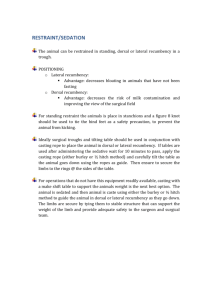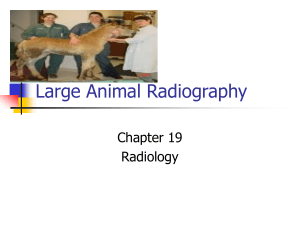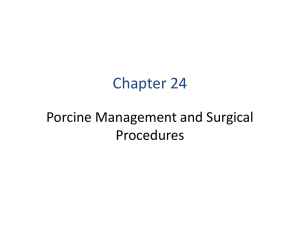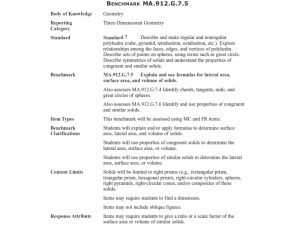Ch. 14-Small Animal Pelvis and Hind Limb
advertisement
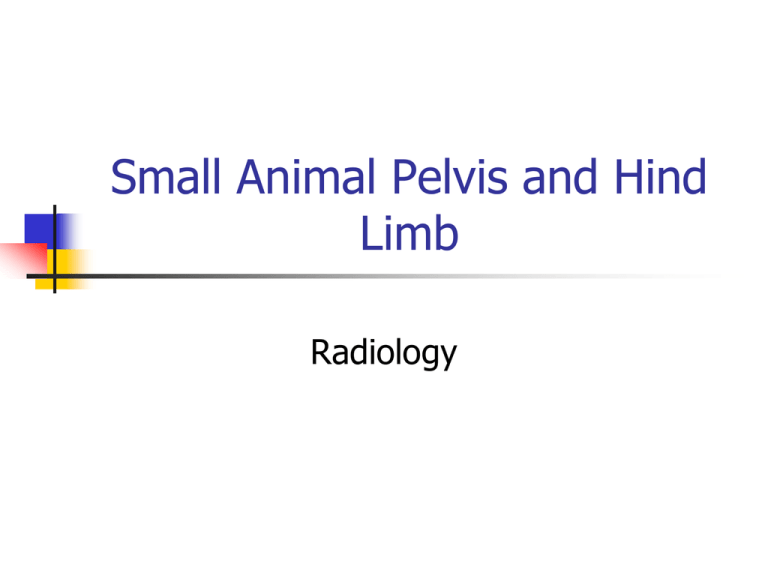
Small Animal Pelvis and Hind Limb Radiology Pelvis Lateral view Patient is in lateral recumbency with side of interest closest to cassette. Femurs should be kept parallel to cassette. Leg closest to cassette should be pulled slightly cranial and leg on top should be pulled slightly caudal. View should include entire pelvis and portion of lumbar spine and femurs. Pelvis should be centered on cassette. Normal Pelvis Lateral View Dye view Pelvis Ventrodorsal view Frog Leg projection Suitable when pelvic trauma is suspected. Minimal stress and tension are placed on the pelvis and hip joints in this projection. Patient is in dorsal recumbency and pelvic limbs can assume a normal, flexed position. Limbs should be positioned identically. Frog Leg projection Pelvis Ventrodorsal View Extended Projection Standard for evaluating hip joints for hip dysplasia. Symmetry and precision is vital for this view. Sedation is generally required (OFA certification). Patient is in dorsal recumbency. Tarsal joints are grasped firmly and rotated in to one another. Positioning continued 1. Femurs are parallel to each other 2. Both patellae are centered between the femoral condyles. 3. Pelvis is without rotation; the obturator foramens, hip joints, hemipelvises, and sacroiliac joints appear as a mirror image. 4. The tail is secured with tape (if necessary) between the femurs. 5. Field of view includes pelvis, femurs, and stifle joints. Positioning for extended view Distracted or PennHIP method Refers to a specific diagnostic technique of hip laxity information. More reliable indication of hip laxity than extended view. Stress radiographic procedure with 3 views (compression, standard extended, and distraction view). To perform this method, veterinarian or technician must be certified. Compressed view Distracted Positioning View Femur Lateral view Patient is in lateral recumbency with affected limb closest to cassette. Opposite limb is abducted and rotated out of line of the x-ray beam. Should include hip joint, femur, and stifle joint. Femur Femur Craniocaudal View Patient is in dorsal recumbency with limb of interest extended caudally. Proper alignment has patella between two femoral condyles. View should include hip joint, femur, and stifle joint. Stifle Joint Caudocranial View Positioned in sternal recumbency with affected limb pulled into position of maximum extension. Opposite limb may be elevated to help control the lateral rotation of the stifle joint under examination. May also do craniocaudal view. Stifle Lateral View Patient is placed in lateral recumbency with affected joint placed and centered on the cassette. Stifle joint should be in a natural, slightly flexed position. Stifle Stifle Joint Skyline Projection of Patella (Sunrise View) Demonstrates changes that can occur to patella and femoral trochlear groove. Patient is in lateral recumbency with the opposite limb down on the table. Affected limb should be in a fully flexed position. Cassette is placed behind stifle joint, vertically, and a horizontal x-ray beam is centered to the patella. Tibia and Fibula Lateral View Patient is in lateral recumbency with affected limb on the cassette. Stifle should be slightly flexed and maintained in true lateral position. Opposite limb pulled cranially or caudally out of x-ray beam. View should include stifle joint, tibia and fibula, and tarsal joint. Tibia and Fibula Caudocranial View Patient is in sternal recumbency with affected limb extended caudally. Tibia and fibula are centered on the cassette. Should be in true caudocranial position so that the patella is placed between the two femoral condyles. View should contain stifle joint, tibia and fibula and tarsal joints. Tarsus Lateral View Patient is in lateral recumbency Tarsus is in a natural, slightly flexed position and centered on the cassette. Tarsus must remain in true lateral postion Opposite leg should be pulled cranially out of x-ray beam. Tarsus Plantardorsal View Placed in sternal recumbency with affected limb extended as for the caudocranial view of tibia and fibula. Tarsus is centered on cassette. Tarsus Dorsoplantar View Placed in sternal recumbency with affected limb extended cranially alongside the body. Metatarsus-Phalanges Lateral View Patient in lateral recumbency with the affected metatarsus centered on the cassette. Opposite limb is pulled caudally or cranially out of view of x-ray beam. Joint is positioned in a natural flexed position. View should include tarsal joint, metatarsal and phalanges Metatarsus-Phalanges Dorsoplantar and Plantardorsal Views Positioned similarly to those of tarsus.
